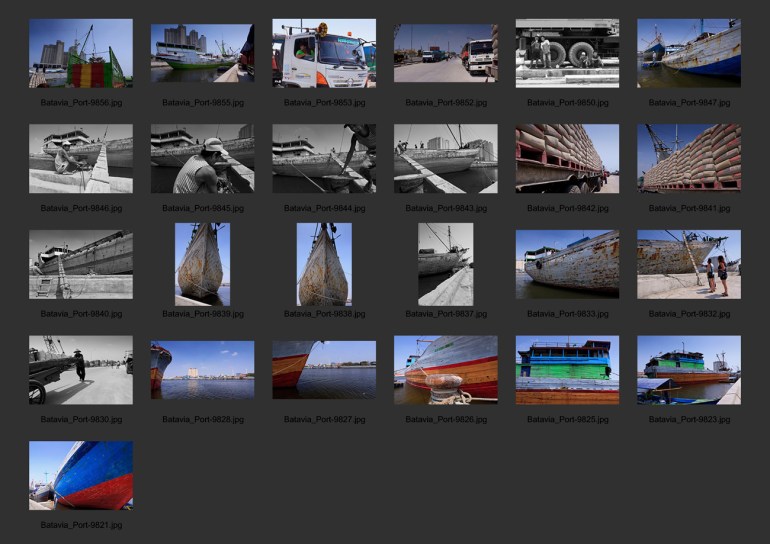Sunda Kelapa, the old harbour of Jakarta, whispers tales of a bygone era.
Known as Batavia until 1949, the port was a centre of trade and cultural exchange; students of Captain James Cook are generally cognisant of Batavia’s prominence in the first voyage story. In this post I’ll take you on a visual journey through Sunda Kelapa, using this captivating location as a springboard to explore the art of choosing the perfect image.
The practice of self assignment can be one of a photographer’s most useful exercises. It is a highly personal experience in which the photographer becomes his own audience—there is no client to please, no specific requirements by which the photographs will be judged. It serves as a way to test your abilities should they ever be offered the “dream” assignment. This is an opportunity to make mistakes and learn from them. Some good images may be captured in the bargain. The purpose beyond any such practice should be to move beyond the ordinary, to break the photographic cliché.
The photographs here were taken at Sunda Kelapa, but they could have been taken anywhere in the world.
They were shot on a guided tour of the old port with my wife Chrissie Terpstra and my sister, our amazing bahasa speaking Jakarta/Borneo/Bali guide, Catherine Anderson.
My premise as photographer was merely to be open to any subject that passed in front of my lens, to see the patterns and shapes that existed, be aware of the hive of human activity associated with a busy port, and be aware of the people’s movements, their labours, their interaction with the surroundings and each other.
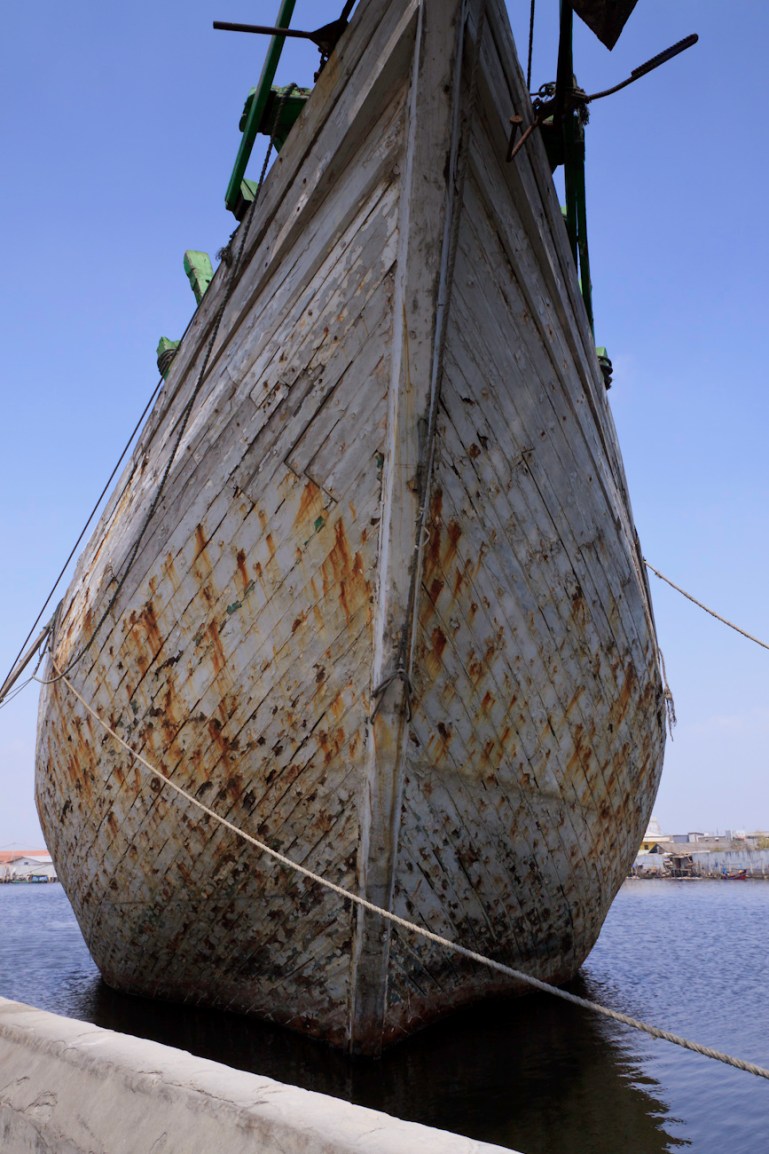
The prow of Bintang Harapan Jaya a magnificent Makassar schooner called Pinisi, Sunda Kelapa, old harbour of Jakarta. Today’s average motorised Pinisi, or Lamba, can load up to 300 ton.
The right picture
In a broad sense, this post is autobiographical. Ansel Adams was right—when a photographer tells us about his pictures, he is telling us about his life.
Picture by picture is a record of the short guided tour I had of the port with my wife Chrissie Terpstra and sister Catherine Anderson, then ex-pat resident of Jakarta, along with my brother in law Gordon. This trip was near the end of the Anderson’s second stint in Indonesia, amounting to about a decade of residency in Indonesia, all told.
This post delves into some of the influences that surround the selection made of photographs from the event. Hopefully, like a good photograph, this post will raise as many questions as it answers.
As photographers we play different photographic roles at different times:
• the journalist, we take a photo,
• the art director, we visualise and make a photo,
• the artist, in the studio or on location we create a photo,
• the critic, we review and assess the photographs of an event or subject.
Photographs encourage us to observe human relationships, to hold on to ordinary moments and surprising moments to inspire and educate us. Pictures display:
-
- love
- hate
- humour
- disgust
- eroticism
- hope
- fantasy
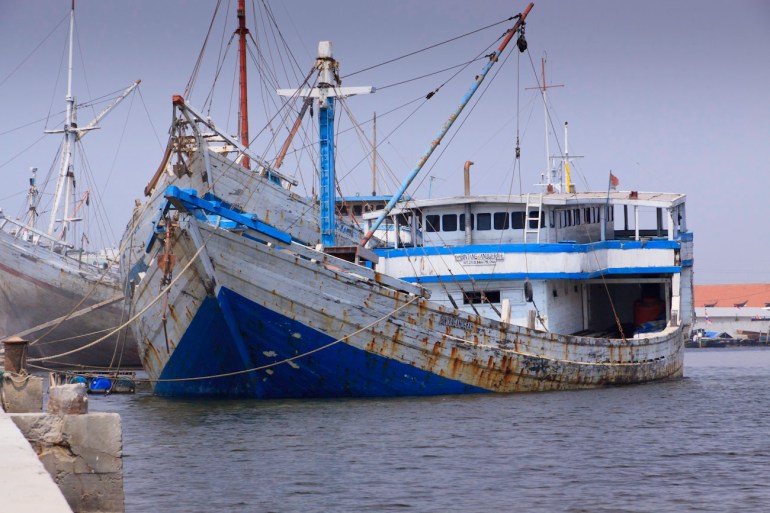
Heavily laden and unladen Lamba type of motorised Pinisi line up at Sunda Kelapa, old harbour of Jakarta. These Pinisi are freighters used to ply a domestic trade between Indonesia and Borneo of palm kernels for Indonesian cement. Today’s average lamba can load up to 300 ton.
These Pinisi pictured are freighters used to ply a domestic trade between Indonesia and Borneo of palm kernels for Indonesian cement.
In a sense this visual essay is a microcosm of the day-to-day process of the developing world developing and what that means for individual people of Indonesia and Borneo.
“A great photo is one that expresses what one feels, in the deepest sense, about what is being photographed, and is thereby a true manifestation of what one feels about life in its entirety.” — Ansel Adams
Such deep questions should ring in a photographer’s mind when he reviews his own “contact sheet” of image library thumbnails downloaded from the camera card.
What deep questions do they feel should be raised by the pictures they choose?
- Which of the images represents the truth?
- Which is a reflection of who he is and what he thinks?
- Do any reveal the event better because of his vision?
- Are these pictures what his life are all about?
Questions like this are doors to a lifetime of inquiry.
Photographs are never complete. There is no mountain high enough for photographing the whole earth. Photography offers us some meaning, but demands that we look for the rest of it in ourselves. A great photograph asks as much from us as it gives to us.
Which of these images represents the whole truth?
What truths do they represent? There are aspects of the mechanics of the trade between the many islands of Indonesia that make it appear as though little has changed for centuries. For example the hazardous occupations at the port of Sunda Kelapa today are still all male dominated, this is true at ports in both the developing and the developed world.
Photographing these working class Indonesians going about their jobs reminded me of my professional stint as a documentary photographer, visual anthropologist of working class men at work in New Zealand, the unsung heroes who are doing what are classed as “death jobs”, the hazardous all-male occupations down in the glass cellar of the everyday Civil Engineering projects going on night and day.
Labouring at a busy port is relatively hazardous work—compared to working in glamour jobs in the law, medicine and the boardroom—likewise mining, forestry or having your hands on the shovels that are doing the drainlaying work of replacing New Zealand’s outmoded, vital, “horizontal infrastructure” below ground in our cities.
The upgrade of New Zealand’s freshwater and sewage pipelines from crumbling Victorian/Edwardian era liability to a state of the art, earthquake proof, century into the future asset. The men who are working in the glass cellar all-male, (95 to 100 percent male,) workplaces in New Zealand, and other Western democracies in the developed world have something in common with the men working as wharfies or coolies of Sunda Kelapa.
Beyond the obvious contrast in this visual essay between the relatively lax workplace safety culture and work methodology in Indonesia, compared with developments in the New Zealand workplace of the past 60 years, these Jakarta port workers, seamen and truck drivers are men doing hazardous work. It is self-evident that they all risk bringing home more than a pay cheque to their loved ones and families.
These photos raise questions about the New Zealand workplace today like;
- what are the numbers of young women who when faced with the broad choice of careers they are free to choose from today, rather than choosing teaching, nursing, early childcare or the law, are choosing to embrace a hazardous career as a roofer, boilermaker, forestry worker, builder, or drainlayer?
- What proportion of young women in New Zealand today are bravely breaking through the glass cellar into the death jobs?
- How many women are stepping up to play their part in making the hazardous workplaces in the glass cellar less sexist, more diverse, inclusive and equitable? Not many. If any.
- What are the number of Indonesian women today campaigning for careers as port workers, merchant seaman and truck drivers?
The lack of diversity inclusion and equity, the lack of equality of outcomes in terms of workplace morbidity and mortality being suffered by men working in the glass cellar’s male dominated “death jobs” is quite likely to go on forever, truths that are masked in New Zealand by media/political ‘Patriarchy Theory’ based obfuscation.
The sterilisation of language in media to remove any gender qualifications means that the fact 93–95 percent of the people who are killed or seriously injured at work are men, and its been that way forever is routinely obscured.
The evidence men dominate workplace death and injury statistics is only made clear if tragic workplace accidents are reported accurately, without misandrist feminist bias in the media. Yet news stories almost always refer simply to ‘worker’, ‘miners’, ‘crew member’, ‘people’ not men—left leaning media mercenaries, and Wikipedia editors, go to great lengths to downplay the mention of the male sex of those who are killed or injured at work.
But I digress.
The Lightroom virtual contact sheet mirrors the photographer’s mind
“What should I photograph?” is one of the questions I have pondered as much as many, maybe more than most. This contact sheet is of the first set of 25 images shot on the tour of the port of Sunda Kelapa. These pictures attempt to depict the situations, scenery, cargo operations, and the Indonesian people, mostly men at work as coolies and seamen, my humanity and my sense of history, my commitment to the history of Indonesia, to humanism. All of that and various abstractions of colour, design and form that made a strong impression.
Thoughts with my picture editors’ hat on
The contact sheet of image thumbnails from an event in Lightroom’s Library view is an incredible instrument for measuring the breadth of a photographer’s vision, but is only as good as the mind that uses it creatively. They are filled with far more information than most of us ever realise. Ingenious image editing can upgrade mediocrity and disguise failure as success.
By revealing all a contact sheet “shows too much”, it discloses how a photographer works technically, but also intellectually and spontaneously. It is interesting to note that Cartier-Bresson would apparently rotate contact sheets in his hands, looking at them from all angles, assessing the formal composition of the photographs (and no doubt alarming the photographer whose work was submitted to such scrutiny).
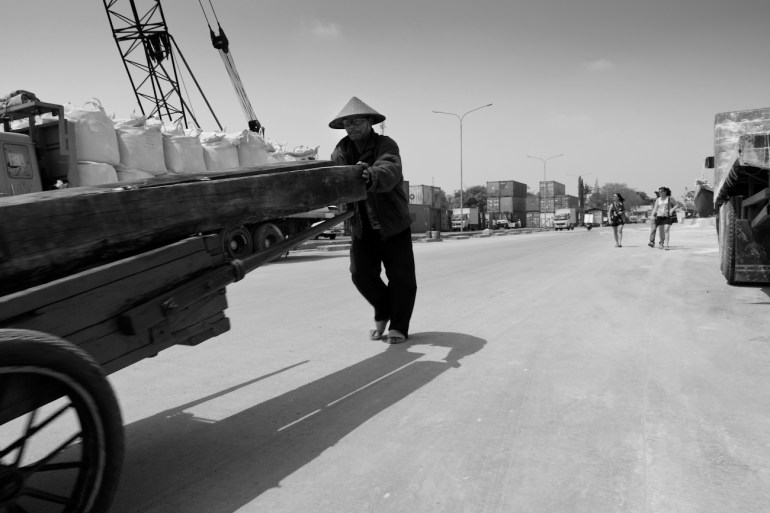
A Coolie transports sawn teak logs on a hand pushed cart in heat of the mid-day sun (Coolie is historical term for manual labourers from Asia), at the port of Sunda Kelapa, Jakarta, Indonesia.
Remember that professional photo journalists’ photos used to be taken to accompany words in an article in a publication. Writers filed stories, and pictures illustrated them.
A great image editor goes to the heart of what is on the contact sheet and tests potential images for certain criteria. I consider whether a good print can be produced from the file. Then decide whether part of the image is greater than the whole and if cropping will enhance communications.
When a single picture can’t tell the whole story I look for a series of that pictures that can. The good editor never discount images that raise questions; they know they are just as important as those that provide answers. They never discount images that raise important ideas, questions, and debates about photography, or he or she cannot be a good editor.
Photo journalism; Photography has an impact on the mind.
In journalism stories do not keep. To be a day late is to belong in yesterday’s newspaper or last week’s magazine.
Photography has an impact on the mind and pictures in old school journalism had to travel through many psyches before they were published.
In legacy media and publishing today the various tastes, thought processes, prejudices and emotional conditions of photographers, picture editors and editors can affect a photograph’s outcome during its journey to the public eye and determine whether or not it appears in a magazine, a website, a book, a blog, a newspaper or hung on a wall.
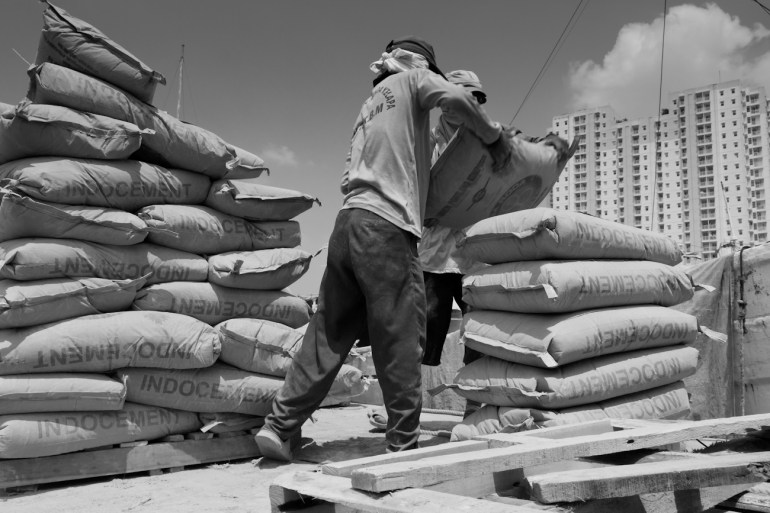
Coolies on the flat deck of a commercial truck alongside a Pinisi freighter load 50 kg bags of Portland Cement onto a wooden pallet to be lifted by a deck crane into the freighter.
Time—a day, a week, months, years—changes what we see in library event thumbnail views by creating distance between the immediate needs of the hour and the inherent timelessness of an image. Pictures tend to change when they are judged without deadline pressures. Time can turn a simple image into a priceless, irreplaceable visual fact. Can the photographer and the picture editor wear historians hats as well? The good ones do.
When a single picture can’t tell the whole story, wearing my image editor’s hat as I shoot, I am aware of opportunities where a series of pictures that form a visual essay, or documentary, can.
Travel photography
Each place I visit has its own particular look, character, atmosphere and dynamics. I want my photographs of Chrissie and my travels to be good and lasting visual narrative, I enjoy the self-assignment of trying to capture all of these qualities, and saying as much about the places I visit as giving the literal look of them. Many of the interesting aspects of the places I am made aware of through prior research.

Photographers with a love of writing photo blog
The best way is for photographers to attract visitors to their photography website is to write about it. The challenge is to find the right photography blogging ideas and the enthusiasm to write consistently and frequently for an indefinite period of time.
There are numerous photographers’ websites that feature only photos but no words. Given that the internet is an infinitely deep well of beautiful images it is easy to understand why their work does not get seen.
When you research and write in short or long-form about a subject you’re really interested in you’re effectively writing adverts for your website and blog, like little search engine fishing nets ready to catch the passing internet search-bot fishes.
You also will, with time and sustained, consistent effort stand out if you think critically, write clearly and speak properly about your subjects. This gives you a level of credibility. The quality of the written word is critical; they always influence a reader’s opinion of the images and the blog—the more pleasant and proper the words, the higher the opinion.
Blogging is a visual medium, every book needs a great cover
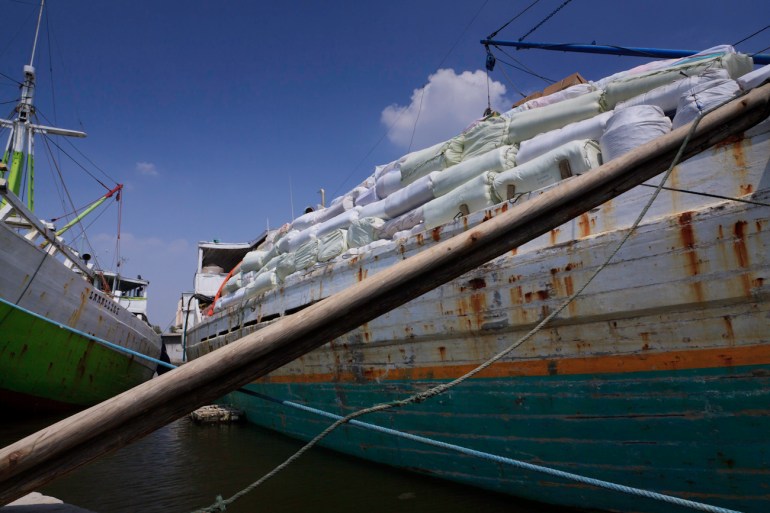
A lamba type of motorised Pinisi named Citra Bahagia laden with cargo at the old port of Sunda Kelapa, Jakarta. Pinisi are a traditional Indonesian two to three-masted sailing ship akin to a cutter. These lamba Pinisi are motorised freighters used to ply a domestic trade between the many islands of Indonesia.
A motorised Pinisi named Citra Bahagia laden with cargo at the old port of Sunda Kelapa, Jakarta, Indonesia.
Bloggers are researchers and writers. They write stories or reports in the form of posts. Blogging is a written, words-based medium, blog images are critical. They are they are the all-important ingredient, second only to a great headline. Every great book needs a cover; every great post needs an image.
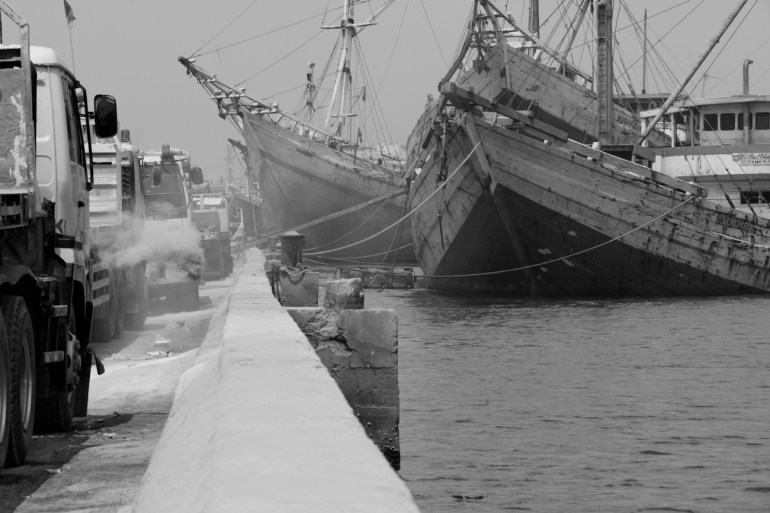
Heavily laden and unladen motorised Pinisi line up alongside the wharf at Sunda Kelapa.
Heavily laden with cement, or quicklime, laden and unladen motorised Pinisi line up alongside the wharf at Sunda Kelapa.
Motorised Pinisi lined up at Sunda Kelapa in August 2018.
Being aware that after his first voyage in October 1770 Captain Cook’s ship the badly damaged Endeavour came into the port of Batavia* in the Dutch East Indies—her crew sworn to secrecy about the lands to the south they had discovered—my having read about the spice trade in ‘Napoleon’s buttons’ I had a particular interest in visiting the old port of Batavia as a keen student of history.
As mentioned, I also became interested on an immediate, human level when I witnessed that the hazardous jobs of port worker, merchant seaman and truck driver are all-male occupations in Indonesia.
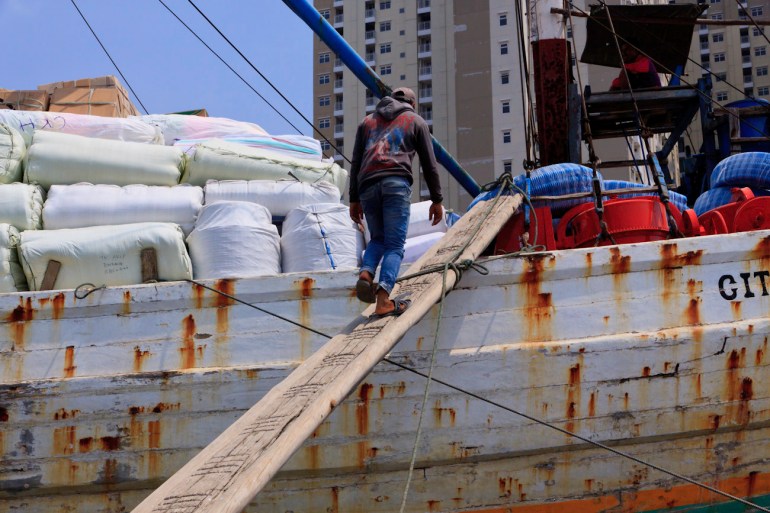
A Coolie walks up the gangplank to board a Pinisi at the port of Sunda Kelapa, Jakarta.
Pinisi are a traditional Indonesian two to three-masted sailing ship.
Many of the Pinisi pictured are engaged as freighters used to ply a domestic trade between Indonesia and Borneo of palm kernels for Indonesian cement. Indonesia is the world’s second-largest producer of palm oil and palm kernels, a by-product of palm oil extraction, both are important export crops.
Borneo must import all its cement for mining, industry and construction.
There is a New Zealand connection to this ‘day in the life’ of Sunda Kelapa.
The Palm Kernel Expeller (PKE), or Palm Kernel cake is made in Indonesia from the palm kernel exported from Borneo, the freight we watched being off-loaded from the Pinisi, this is connected to New Zealand’s primary export earning industry.
Palm Kernel cake is a by-product of the palm oil extraction process from the fruit of the palm. It is made from the pulp left after oil is rendered from the kernel in Indonesia, and is formed into “palm kernel cake”, used as high-protein feed for dairy cattle.
PKE is a quality stock feed containing high levels of crude protein that New Zealand imports from Indonesia for its primary export earning industry, dairy industry.
Assessing the differences between colour and black and white photography
A good photographer is constantly assessing the differences between his colour and his black and white photography.
This issue also concerned Ansel Adams, as well as many photographers working today. “Colour photography usually takes advantage of the obvious,” wrote Adams. Black-and-white photography fares better, as its inherent abstraction takes the viewer out of the morass of manifest appearance and encourages inspection of shapes, textures, and qualities of light.
When reviewing your photos with your picture editor hat on you must also have access to important ideas, questions, and debates about photography to be a good editor.
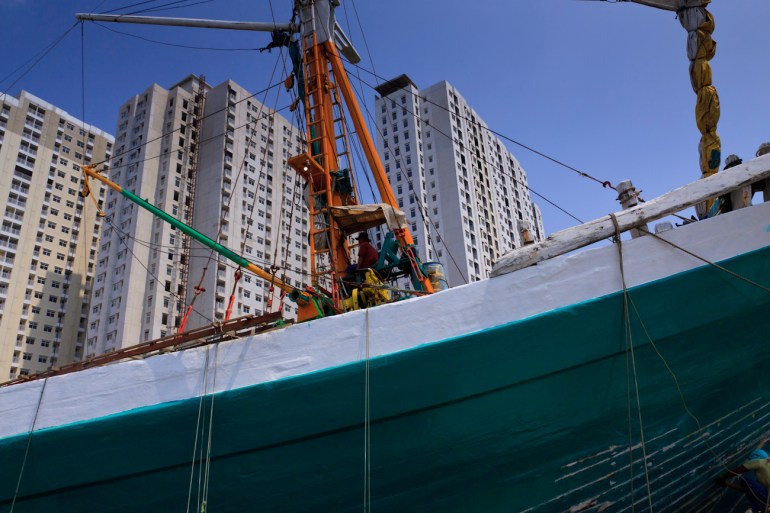
A Pinisi deck crane and operator dwarfed by a backdrop of towering apartment blocks, port of Sunda Kelapa, old harbour of Jakarta, Indonesia.
The photographer’s input, however, is essential to good journalism.
The eye-witness to a story should be included. How can all the non-visual information he or she has collected be ignored?
At some magazines photographers are part of the editing and layout process. New digital technologies have meant that photographers are getting more involved in the editing act. For some time now great news articles have been referred to as “literature under pressure.” Is it true now to say that great news and journalistic photographs rate being called “art under pressure?”
Broadly, the dual roles of photographer and being one’s own image editor is autobiographical
Virtual contact sheets of event thumbnails mirror the photographer’s mind. They are filled with far more information than most of us ever realise. Edited library grid views reflect the quality of the editor, too. An inexperienced editor will reveal themselves by the pictures he doesn’t choose. A great editor goes to the heart of what is in the library view by pulling out the best frames, then selecting subtle, intriguing images to augment and enhance the blockbuster photographs.
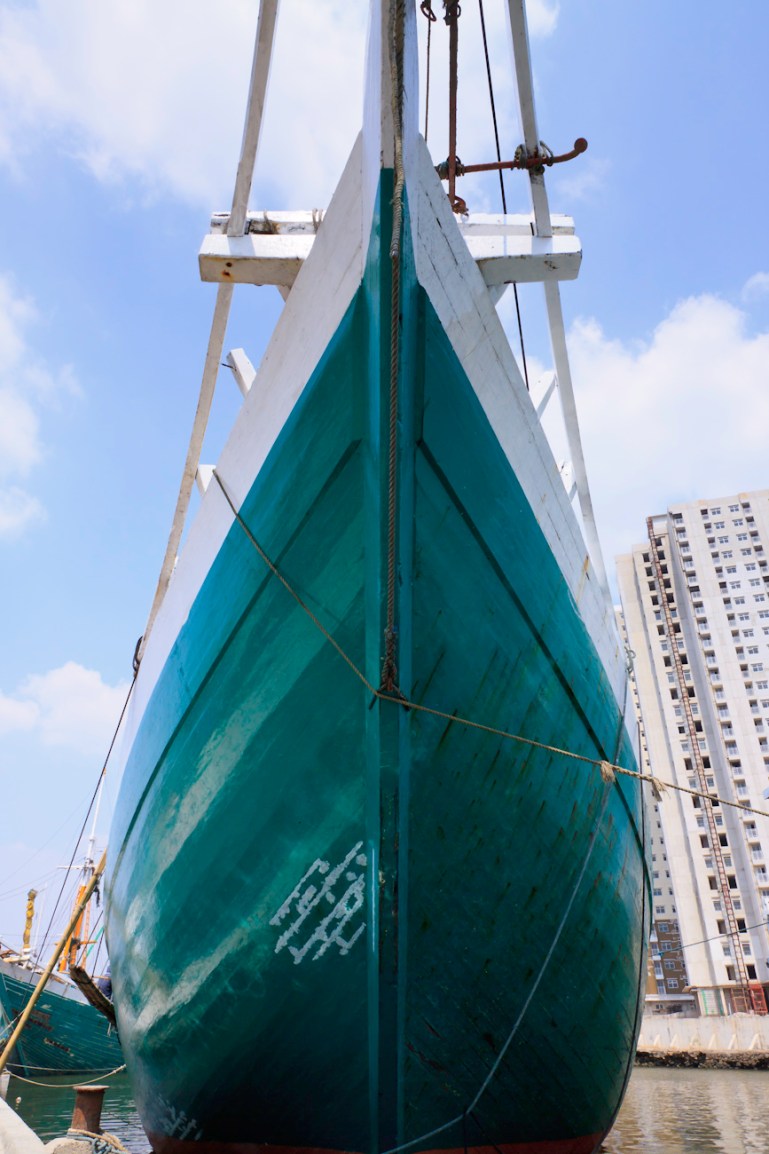
The prow of a magnificent Pinisi traditional Indonesian boat. Port of Sunda Kelapa, old harbour, Jakarta.
Picture by picture, event by event, in my image library I show the life I have led. Underneath my images lies the story of my own becoming, which includes some surprises.
I have touched and been touched by some of the most interesting personalities on my way through life. My ability to make conversation, and the interest I take in exploring important ideas in art, communications, evolutionary biology, the sciences, skepticism and social anthropology keeps me on my toes, reading, listening and absorbing.
I often feel conflicted when switching roles between photographer and image editor. It is good for me wearing each of those two hats and both of them that I do.
Without debate, truth dies of boredom. To be of any value, every thumbnail grid of an event should be the beginning of an argument about which images have most merit. This blog post describes some of the influences that surround a photograph as it is being passed from my photographer’s eye to my image editor’s critical aesthetic eye and sense of visual documentary narrative.
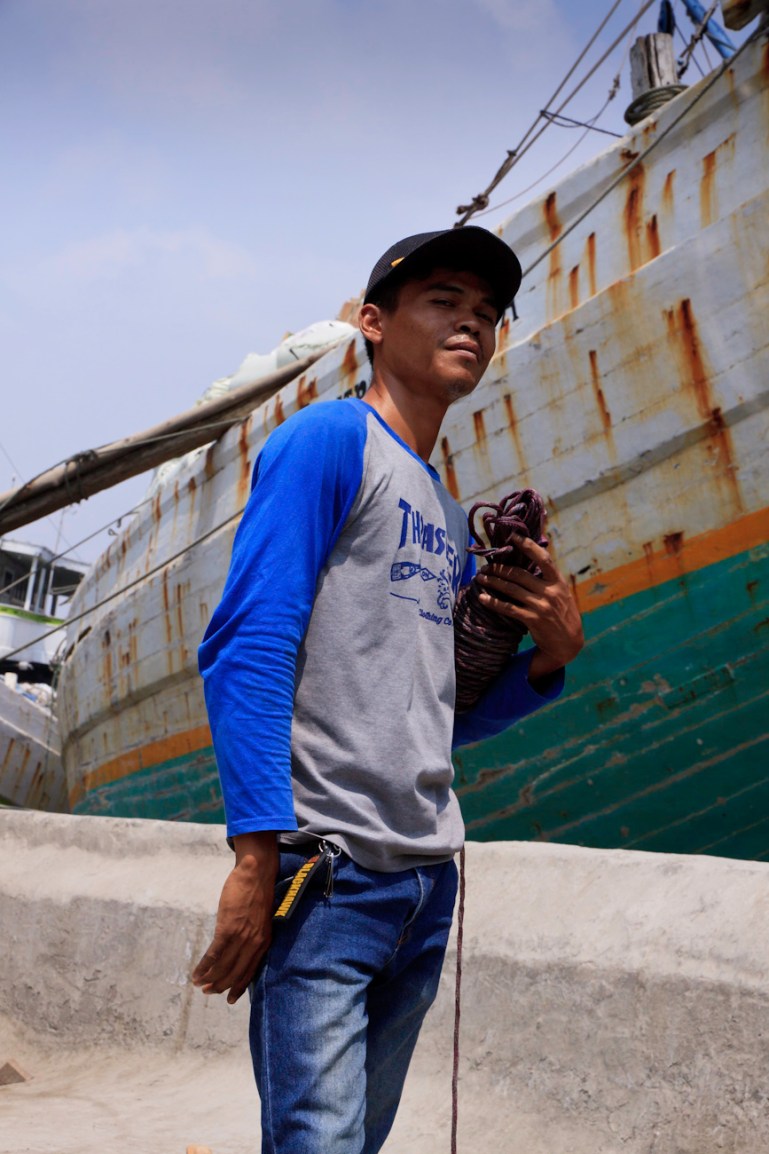
A young Coolie cops a pose for a portrait on the wharf at the old port of Sunda Kelapa, Jakarta, Indonesia.
Informal portaiture using available light
Avoid distraction from the most important purpose—getting photographs.
Whether shooting outdoors or indoors, consider using the flash to light the subject. If the available light is insufficient then you need to build up more light until the clearest and best photo can be taken. This may involve bouncing flash light up off the ceiling or outdoor canopy. You shouldn’t see light in the final picture—you should see the subject.
Dropping to one knee and shooting up at your subject yields a heroic image.
Quick guide to shooting portraiture using a a 1/1.6x crop smaller sensor camera
The Canon 50D and 60D have a 1/1.6x crop due to smaller sensor, so relative to a full sensor camera like the Canon 5D;
- 50mm full = 31mm equivalent on the 15–85mm zoom lens (24–136mm full frame equivalent)
- 35mm full = 22mm equivalent on the 15–85mm zoom lens (24–136mm full frame equivalent)
- 21mm full = 13mm equivalent on the 15–85mm zoom lens (10–22mm full frame equivalent)
The 35mm lens is great for environmental portraiture where you want to show a person in an entire scene. The thing with a 50mm lens is that it makes you get close to people and you need to shoot portraits from about 2m away or closer taking in no more than the upper quarter of the person to avoid unflattering lens distortion.
A 50mm lens makes you get close to people and you need to shoot portraits from about 2m away.
The particular look and character of Indonesian trucks of Sunda Kelapa old harbour
As a graphic designer, i fell in love with customized truck fronts while traveling in Indonesia, at the port of Sunda Kelapa there is a great concentration of them.
Visual anthropology: social photography and work methodology photography
Anthropology is a field that values good, factual photography more than beautiful pictures. A moody shot of a mother holding a child will not work, whereas a picture of an entire family with all their belongings standing before a straw house has a great deal of information.
As an artist I have various goals in mind when I photograph people. I accentuate special characteristics and play with composition and graphic devices. As a documentary photographer with an anthropological bent I must capture visually readable, factual data. This event demonstrates both aspects of my photography.

Three coolie wharf labourer customers buying lunch from a mobile cafeteria on a scooter, Sunda Kelapa, old harbour Jakarta.
Trying to understand people gives meaning to the world.
I took these photographs to talk about and show these people as they were, getting as much information as I could without losing the viewer’s interest. I composed my pictures carefully and waited for special, revealing moments, sometimes shooting in high speed continuous burst mode to be sure to capture just the right moment.
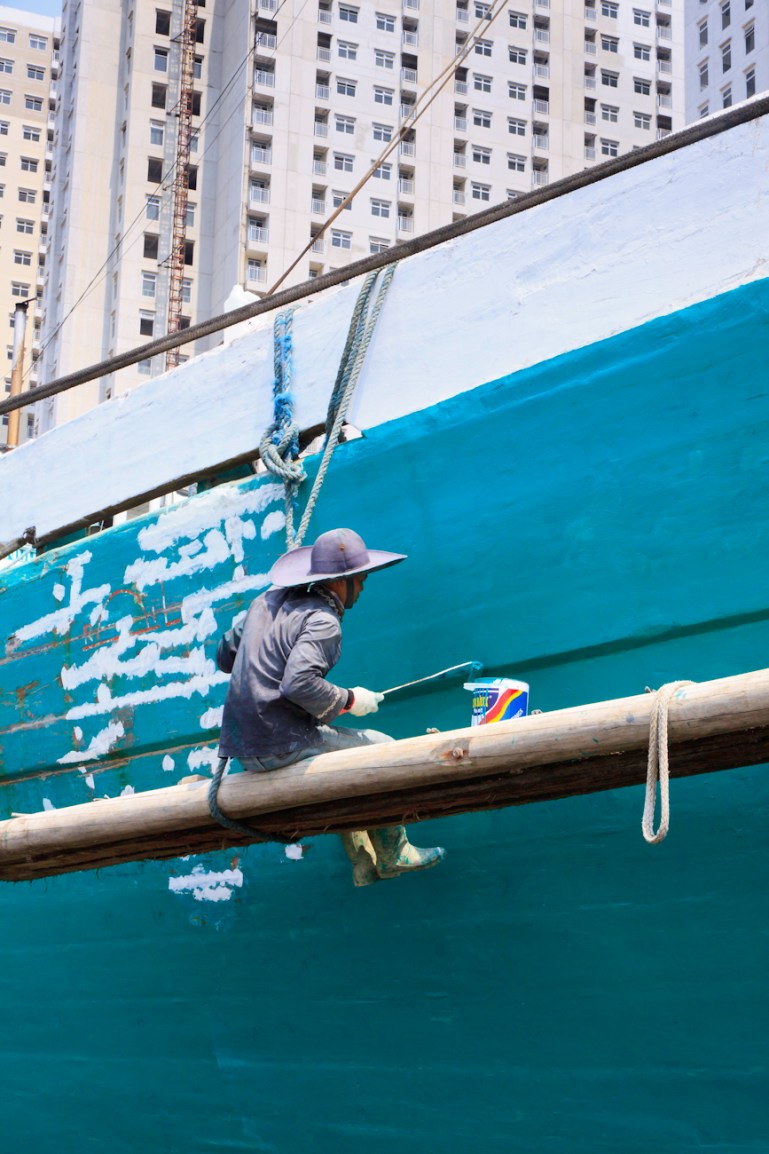
The midships of a motorised Pinisi being repainted with roller applied lacquer by a Coolie working off a suspended plank. Towering high rise apartment blocks provide the backdrop, Sunda Kelapa, old harbour, Jakarta.
Tough shooting situations make war on my photographer’s senses. I need to be thinking on several levels all at the same time.
There are times when I might shoot five or six pictures besides the one obvious candidate. This comes from the discipline of what you could call visual anthropology. I haven’t stopped fact hunting or searching for relationships and compositions and visually interesting graphical elements.
The difference between a frame with colour and form well placed within the image, and one that is ill-conceived, is the difference between mediocrity and art. Intuition and sensitivity to the elements,—balance, tension, line, light colour and movement—come into play when the photographer finds the right picture. That moment is one of a photographer’s thrills.
To see and capture the right image from real life quickly and with certainty—that is photography at its best.
Credits
Design firm: MagentaDot Brands
Photographer / picture editor: Shaun Waugh
Client: Self assignment
H/t: A photographer and a picture editor demonstrate how to choose—The Right Picture | Ken Herman, John Durniak | 1986 | ISBN 0-8174-5726-7

